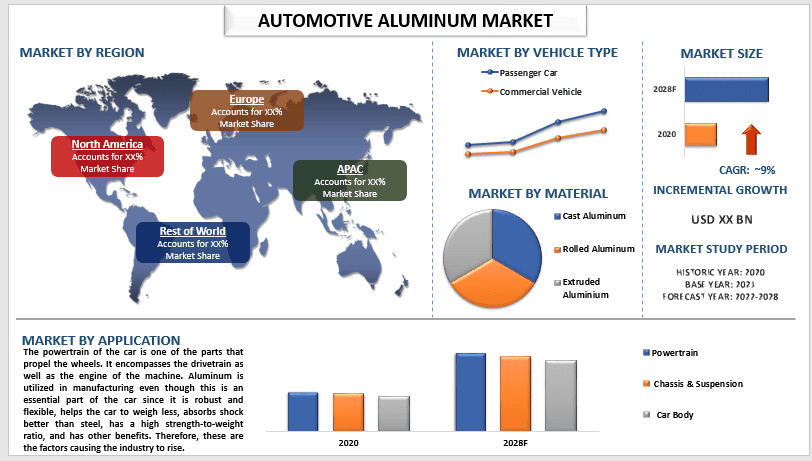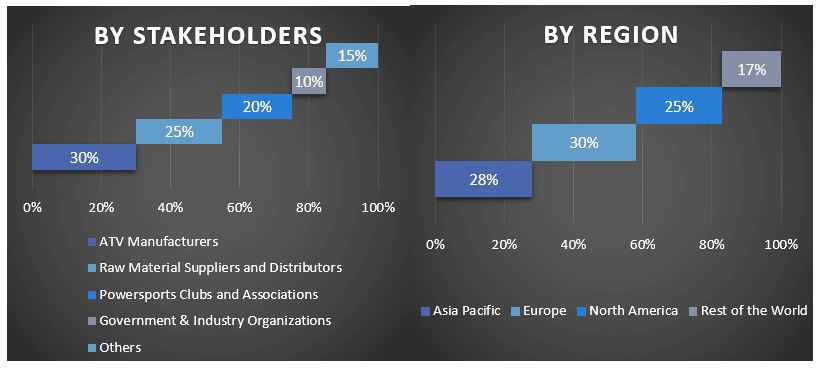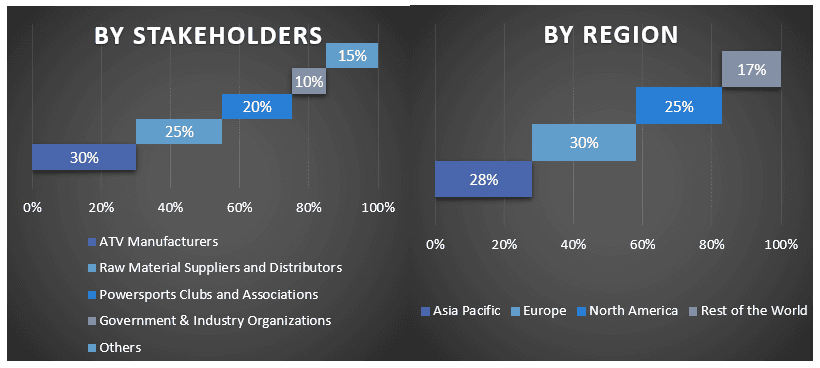Emphasis on Application (Powertrain, Chassis & Suspension, and Car Body); Material (Cast Aluminum, Rolled Aluminum, and Extruded Aluminum); Vehicle Type (Passenger Cars and Commercial Vehicles)); and Region/Country

The Global Automotive aluminum market is expected to grow at a significant rate of around 9% during the forecast period. Aluminum is used in the automobile industry to create the body, frame, wheels, fuel systems, heat shields, and interiors of vehicles. Additionally, it is employed in the manufacture of numerous engine components, including cylinder heads, pistons, and radiators. Moreover, aluminum provides great stability, durability, and cost-effectiveness due to its lightweight, which is used in both passenger and commercial vehicles. Aluminum components assist a vehicle to accelerate more quickly and absorb more stress during an accident or collision than steel components do.
Some of the major players operating in the market include Alcoa Corporation, Novelis Inc., UACJ Corporation, Norsk Hydro ASA, AMG Advanced Metallurgical Group N.V., Constellium SE, Aluminum Corporation of China Limited, Rio Tinto Group, Aleris Corporation, and Jindal Aluminum. are some of the key players in the market. Several M&As along with partnerships have been undertaken by these players to facilitate customers with hi-tech and innovative products/technologies.
Insights Presented in the Report
“Amongst application, powertrain category to witness robust CAGR during the forecast period”
Based on material, the market is segmented into powertrain, chassis & suspension, and car body. The powertrain category is to witness a higher CAGR during the forecast. The powertrain of the car is one of the parts that propel the wheels. It encompasses the drivetrain as well as the engine of the machine. Aluminum is utilized in manufacturing even though this is an essential part of the car since it is robust and flexible, helps the car to weigh less, absorbs shock better than steel, has a high strength-to-weight ratio, and has other benefits. Therefore, these are the factors causing the industry to rise.
“Amongst application, the cast aluminum to hold a significant share in the market in 2020”
Based on application, the market is categorized into cast aluminum, rolled aluminum, and extruded aluminum. Among these, cast aluminum is to hold a significant share of the market in 2020. This is primarily because aluminum has a wide range of beneficial features, including practical strength, low density, high thermal conductivity, great machining behavior, and strong corrosion resistance. These are the primary advantages fueling the market’s expansion.
“North America to hold a significant share in the market”
In 2020, North America held a significant share of the global automotive aluminum market. Due to the high volume of vehicles produced and the introduction of corporate average fuel economy standards, which provide guidance to the auto industry to maintain fuel efficiency in the region, North America is predicted to increase at a significant CAGR throughout the projection period. Additionally, due to the region’s increasing industrialization, the Asia-Pacific region’s market is expanding at the quickest rate in the world. Because there is more discretionary money in the region, there is a growing demand for luxury automobiles, which has led to constant expansion in the Asia-Pacific automotive aluminum market.
Reasons to buy this report:
Customization Options:
The global automotive aluminum market can further be customized as per the requirement or any other market segment. Besides this, UMI understands that you may have your own business needs, hence feel free to connect with us to get a report that completely suits your requirements.
1. Market Introduction
2. Research Methodology Or Assumption
3. Market Synopsis
4. Executive Summary
5. Impact Of Covid-19 On The Automotive Aluminium Market
6. Automotive Aluminium Market Revenue, 2020-2028f
7. Market Insights By Application
8. Market Insights By Material
9. Market Insights By Vehicle Type
10. Market Insights By Region
11. Automotive Aluminium Market Dynamics
12. Automotive Aluminium Market Opportunities
13. Automotive Aluminium Market Trends
14. Demand And Supply-side Analysis
15. Value Chain Analysis
16. Competitive Scenario
17. Company Profiled
18. Disclaimer
Research Methodology for the Automotive Aluminum market Analysis (2022-2028)
Analyzing the historical market, estimating the current market, and forecasting the future market of the global automotive aluminum market were the three major steps undertaken to create and analyze the adoption of automotive aluminum markets in major regions globally. Exhaustive secondary research was conducted to collect the historical market numbers and estimate the current market size. Secondly, to validate these insights, numerous findings and assumptions were taken into consideration. Moreover, exhaustive primary interviews were also conducted, with industry experts across the value chain of the global automotive aluminum market. Post assumption and validation of market numbers through primary interviews, we employed a top-down/bottom-up approach to forecasting the complete market size. Thereafter, market breakdown and data triangulation methods were adopted to estimate and analyze the market size of segments and sub-segments of the industry pertains to. Detailed methodology is explained below:
Analysis of Historical Market Size
Step 1: In-Depth Study of Secondary Sources:
Detail secondary study was conducted to obtain the historical market size of the automotive aluminum market through company internal sources such as annual reports & financial statements, performance presentations, press releases, etc., and external sources including journals, news & articles, government publications, competitor publications, sector reports, third-party database, and other credible publications.
Step 2: Market Segmentation:
After obtaining the historical market size of the automotive aluminum market, we conducted a detailed secondary analysis to gather historical market insights and share for different segments & sub-segments for major regions. Major segments are included in the report as type, drive type, and application. Further country-level analyses were conducted to evaluate the overall adoption of testing models in that region.
Step 3: Factor Analysis:
After acquiring the historical market size of different segments and sub-segments, we conducted a detailed factor analysis to estimate the current market size of the automotive aluminum market. Further, we conducted factor analysis using dependent and independent variables such as material, application, and vehicle type of automotive aluminum markets. A thorough analysis was conducted for demand and supply-side scenarios considering top partnerships, mergers and acquisitions, business expansion, and product launches in the automotive aluminum market sector across the globe.
Current Market Size Estimate & Forecast
Current Market Sizing: Based on actionable insights from the above 3 steps, we arrived at the current market size, key players in the global automotive aluminum market, and market shares of the segments. All the required percentage shares split, and market breakdowns were determined using the above-mentioned secondary approach and were verified through primary interviews.
Estimation & Forecasting: For market estimation and forecast, weights were assigned to different factors including drivers & trends, restraints, and opportunities available for the stakeholders. After analyzing these factors, relevant forecasting techniques i.e., the top-down/bottom-up approach were applied to arrive at the market forecast for 2028 for different segments and sub-segments across the major markets globally. The research methodology adopted to estimate the market size encompasses:
Market Size and Share Validation
Primary Research: In-depth interviews were conducted with the Key Opinion Leaders (KOLs) including Top Level Executives (CXO/VPs, Sales Head, Marketing Head, Operational Head, Regional Head, Country Head, etc.) across major regions. Primary research findings were then summarized, and statistical analysis was performed to prove the stated hypothesis. Inputs from primary research were consolidated with secondary findings, hence turning information into actionable insights.
Split of Primary Participants in Different Regions

Market Engineering
The data triangulation technique was employed to complete the overall market estimation and to arrive at precise statistical numbers for each segment and sub-segment of the global automotive aluminum market. Data was split into several segments & sub-segments post studying various parameters and trends in the areas of material, application, and vehicle type in the global automotive aluminum market.
The main objective of the Global Automotive aluminum market Study
The current & future market trends of the global automotive aluminum market were pinpointed in the study. Investors can gain strategic insights to base their discretion for investments on the qualitative and quantitative analysis performed in the study. Current and future market trends determined the overall attractiveness of the market at a regional level, providing a platform for the industrial participant to exploit the untapped market to benefit from a first-mover advantage. Other quantitative goals of the studies include:

Customers who bought this item also bought